Continental AG: Business Environment Analysis and Operations Report
VerifiedAdded on 2020/11/12
|12
|3220
|396
Report
AI Summary
This report provides a comprehensive analysis of Continental AG's business environment and operations, focusing on its presence in Sweden. The introduction gives a brief overview of Continental AG's history, mission, and global operations, highlighting its expansion into the Swedish market. Task 1 delves into background information about the company, including its structure, divisions, and international operations. It also examines the business environment in Sweden using the PESTLE analysis, covering political, economic, social, technological, legal, and environmental factors. Furthermore, the report applies Porter's Five Forces model to evaluate the competitive landscape of Continental AG, assessing the threats of new entrants, the bargaining power of suppliers and buyers, the threat of substitute products or services, and the intensity of competitive rivalry. The analysis provides a detailed understanding of the challenges and opportunities faced by Continental AG in the Swedish market.
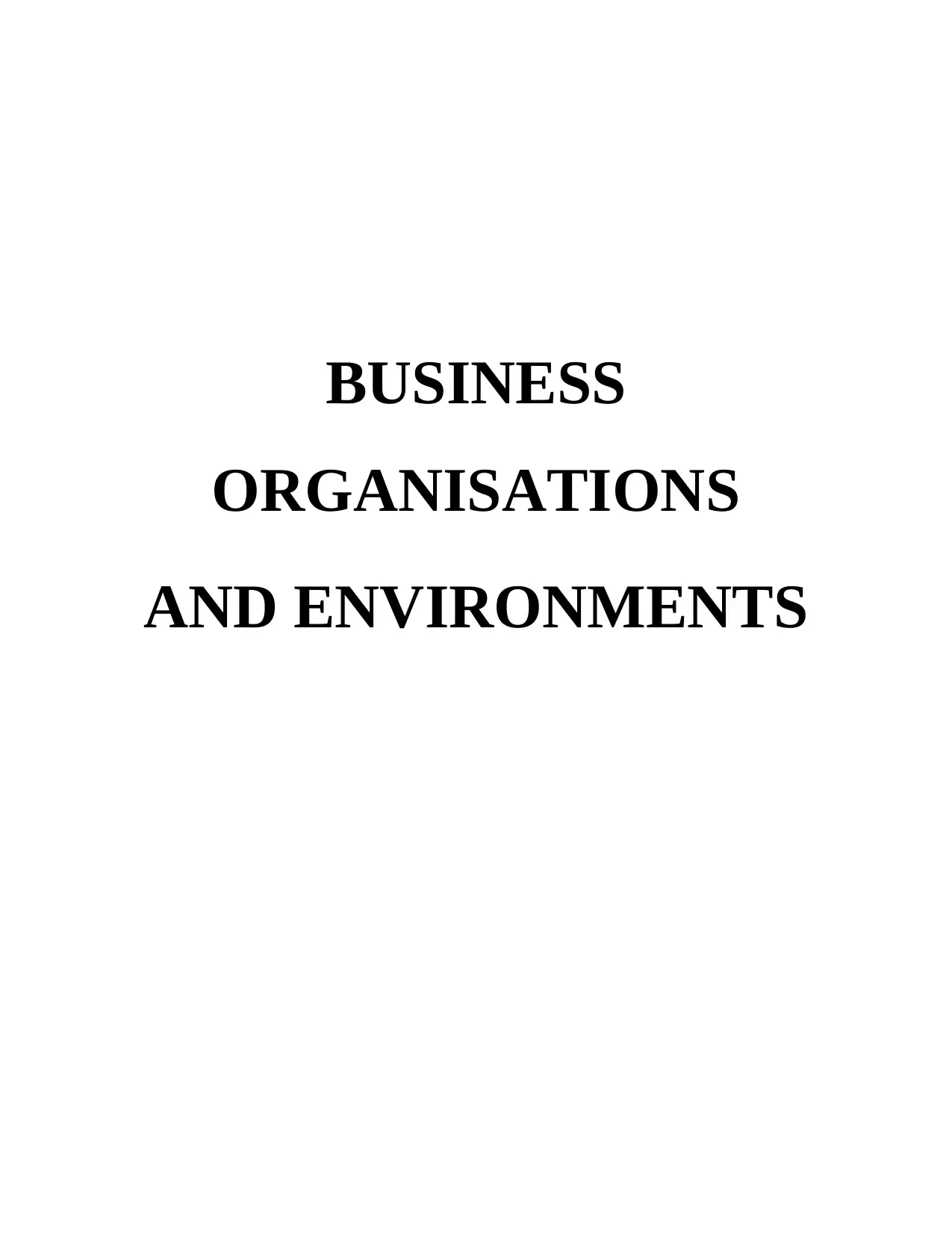
BUSINESS
ORGANISATIONS
AND ENVIRONMENTS
ORGANISATIONS
AND ENVIRONMENTS
Paraphrase This Document
Need a fresh take? Get an instant paraphrase of this document with our AI Paraphraser
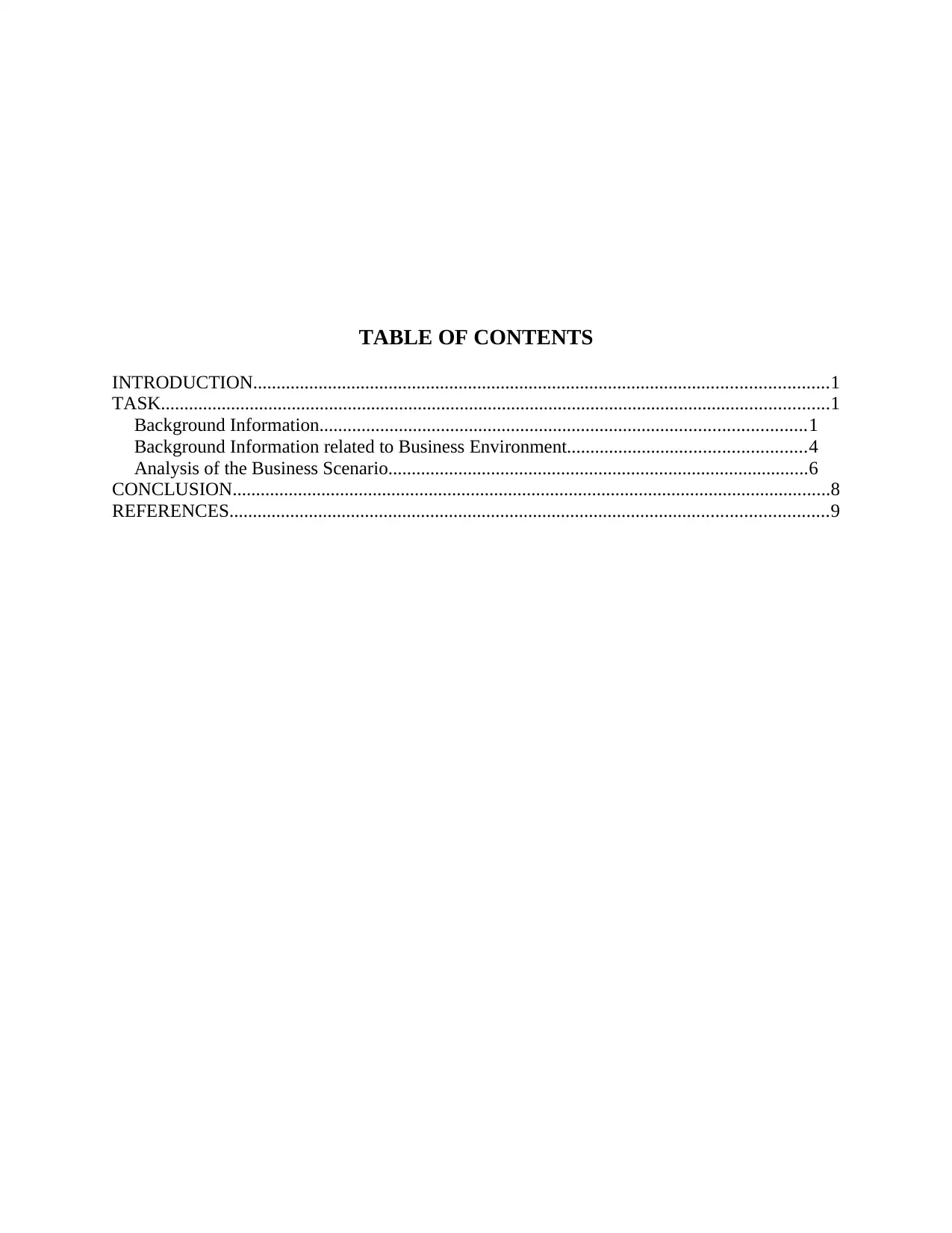
TABLE OF CONTENTS
INTRODUCTION...........................................................................................................................1
TASK...............................................................................................................................................1
Background Information........................................................................................................1
Background Information related to Business Environment...................................................4
Analysis of the Business Scenario..........................................................................................6
CONCLUSION................................................................................................................................8
REFERENCES................................................................................................................................9
INTRODUCTION...........................................................................................................................1
TASK...............................................................................................................................................1
Background Information........................................................................................................1
Background Information related to Business Environment...................................................4
Analysis of the Business Scenario..........................................................................................6
CONCLUSION................................................................................................................................8
REFERENCES................................................................................................................................9
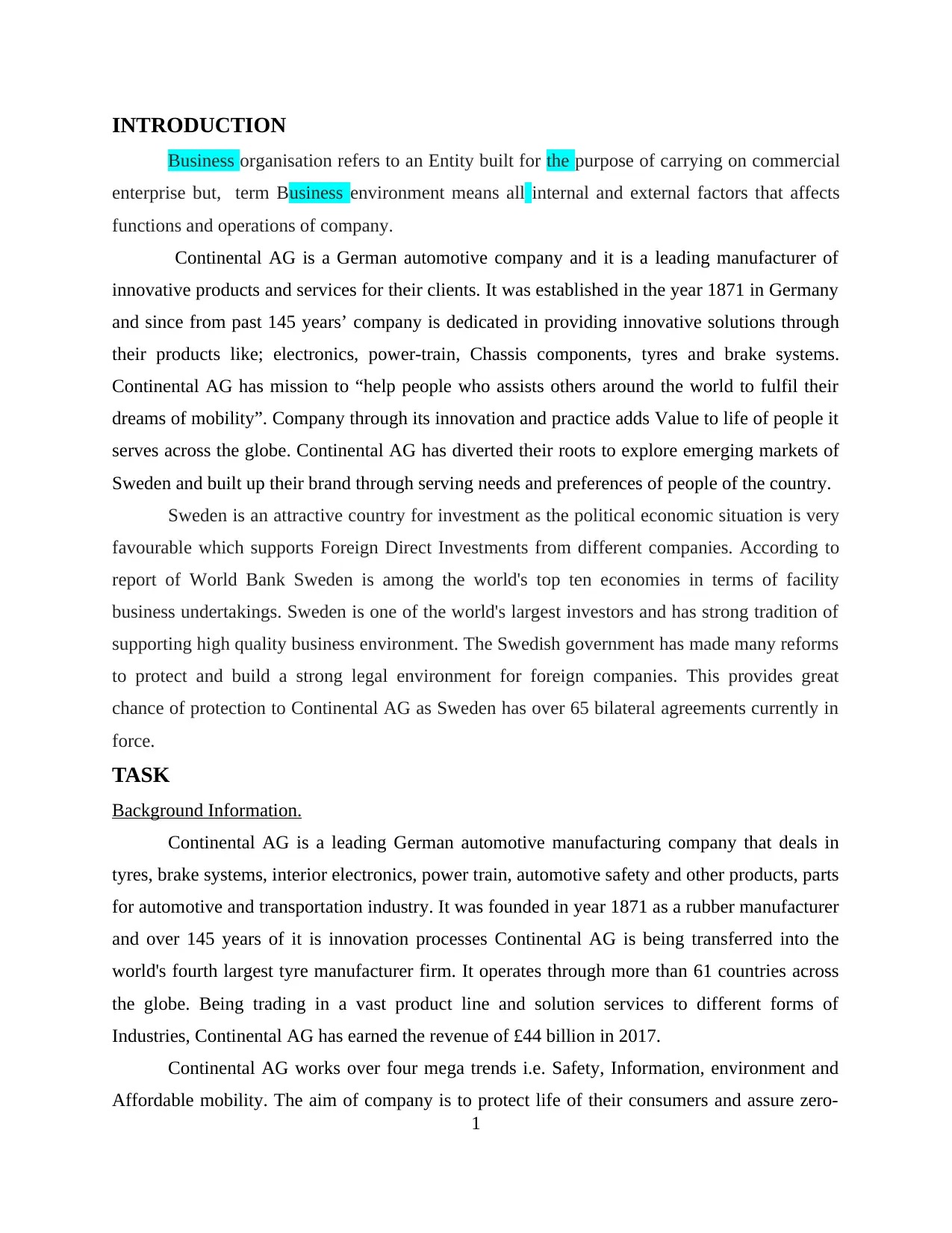
INTRODUCTION
Business organisation refers to an Entity built for the purpose of carrying on commercial
enterprise but, term Business environment means all internal and external factors that affects
functions and operations of company.
Continental AG is a German automotive company and it is a leading manufacturer of
innovative products and services for their clients. It was established in the year 1871 in Germany
and since from past 145 years’ company is dedicated in providing innovative solutions through
their products like; electronics, power-train, Chassis components, tyres and brake systems.
Continental AG has mission to “help people who assists others around the world to fulfil their
dreams of mobility”. Company through its innovation and practice adds Value to life of people it
serves across the globe. Continental AG has diverted their roots to explore emerging markets of
Sweden and built up their brand through serving needs and preferences of people of the country.
Sweden is an attractive country for investment as the political economic situation is very
favourable which supports Foreign Direct Investments from different companies. According to
report of World Bank Sweden is among the world's top ten economies in terms of facility
business undertakings. Sweden is one of the world's largest investors and has strong tradition of
supporting high quality business environment. The Swedish government has made many reforms
to protect and build a strong legal environment for foreign companies. This provides great
chance of protection to Continental AG as Sweden has over 65 bilateral agreements currently in
force.
TASK
Background Information.
Continental AG is a leading German automotive manufacturing company that deals in
tyres, brake systems, interior electronics, power train, automotive safety and other products, parts
for automotive and transportation industry. It was founded in year 1871 as a rubber manufacturer
and over 145 years of it is innovation processes Continental AG is being transferred into the
world's fourth largest tyre manufacturer firm. It operates through more than 61 countries across
the globe. Being trading in a vast product line and solution services to different forms of
Industries, Continental AG has earned the revenue of £44 billion in 2017.
Continental AG works over four mega trends i.e. Safety, Information, environment and
Affordable mobility. The aim of company is to protect life of their consumers and assure zero-
1
Business organisation refers to an Entity built for the purpose of carrying on commercial
enterprise but, term Business environment means all internal and external factors that affects
functions and operations of company.
Continental AG is a German automotive company and it is a leading manufacturer of
innovative products and services for their clients. It was established in the year 1871 in Germany
and since from past 145 years’ company is dedicated in providing innovative solutions through
their products like; electronics, power-train, Chassis components, tyres and brake systems.
Continental AG has mission to “help people who assists others around the world to fulfil their
dreams of mobility”. Company through its innovation and practice adds Value to life of people it
serves across the globe. Continental AG has diverted their roots to explore emerging markets of
Sweden and built up their brand through serving needs and preferences of people of the country.
Sweden is an attractive country for investment as the political economic situation is very
favourable which supports Foreign Direct Investments from different companies. According to
report of World Bank Sweden is among the world's top ten economies in terms of facility
business undertakings. Sweden is one of the world's largest investors and has strong tradition of
supporting high quality business environment. The Swedish government has made many reforms
to protect and build a strong legal environment for foreign companies. This provides great
chance of protection to Continental AG as Sweden has over 65 bilateral agreements currently in
force.
TASK
Background Information.
Continental AG is a leading German automotive manufacturing company that deals in
tyres, brake systems, interior electronics, power train, automotive safety and other products, parts
for automotive and transportation industry. It was founded in year 1871 as a rubber manufacturer
and over 145 years of it is innovation processes Continental AG is being transferred into the
world's fourth largest tyre manufacturer firm. It operates through more than 61 countries across
the globe. Being trading in a vast product line and solution services to different forms of
Industries, Continental AG has earned the revenue of £44 billion in 2017.
Continental AG works over four mega trends i.e. Safety, Information, environment and
Affordable mobility. The aim of company is to protect life of their consumers and assure zero-
1
⊘ This is a preview!⊘
Do you want full access?
Subscribe today to unlock all pages.

Trusted by 1+ million students worldwide
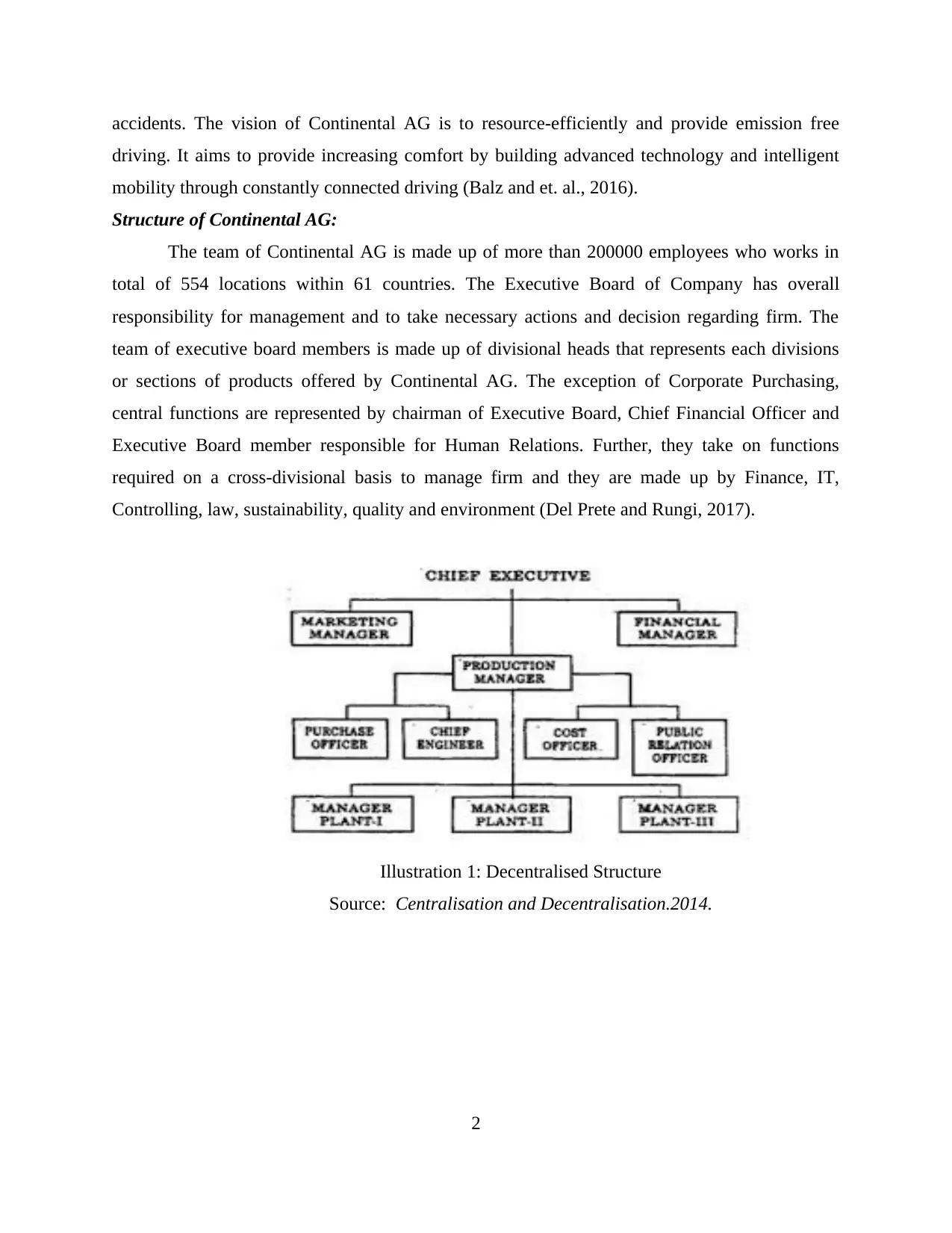
accidents. The vision of Continental AG is to resource-efficiently and provide emission free
driving. It aims to provide increasing comfort by building advanced technology and intelligent
mobility through constantly connected driving (Balz and et. al., 2016).
Structure of Continental AG:
The team of Continental AG is made up of more than 200000 employees who works in
total of 554 locations within 61 countries. The Executive Board of Company has overall
responsibility for management and to take necessary actions and decision regarding firm. The
team of executive board members is made up of divisional heads that represents each divisions
or sections of products offered by Continental AG. The exception of Corporate Purchasing,
central functions are represented by chairman of Executive Board, Chief Financial Officer and
Executive Board member responsible for Human Relations. Further, they take on functions
required on a cross-divisional basis to manage firm and they are made up by Finance, IT,
Controlling, law, sustainability, quality and environment (Del Prete and Rungi, 2017).
2
Illustration 1: Decentralised Structure
Source: Centralisation and Decentralisation.2014.
driving. It aims to provide increasing comfort by building advanced technology and intelligent
mobility through constantly connected driving (Balz and et. al., 2016).
Structure of Continental AG:
The team of Continental AG is made up of more than 200000 employees who works in
total of 554 locations within 61 countries. The Executive Board of Company has overall
responsibility for management and to take necessary actions and decision regarding firm. The
team of executive board members is made up of divisional heads that represents each divisions
or sections of products offered by Continental AG. The exception of Corporate Purchasing,
central functions are represented by chairman of Executive Board, Chief Financial Officer and
Executive Board member responsible for Human Relations. Further, they take on functions
required on a cross-divisional basis to manage firm and they are made up by Finance, IT,
Controlling, law, sustainability, quality and environment (Del Prete and Rungi, 2017).
2
Illustration 1: Decentralised Structure
Source: Centralisation and Decentralisation.2014.
Paraphrase This Document
Need a fresh take? Get an instant paraphrase of this document with our AI Paraphraser
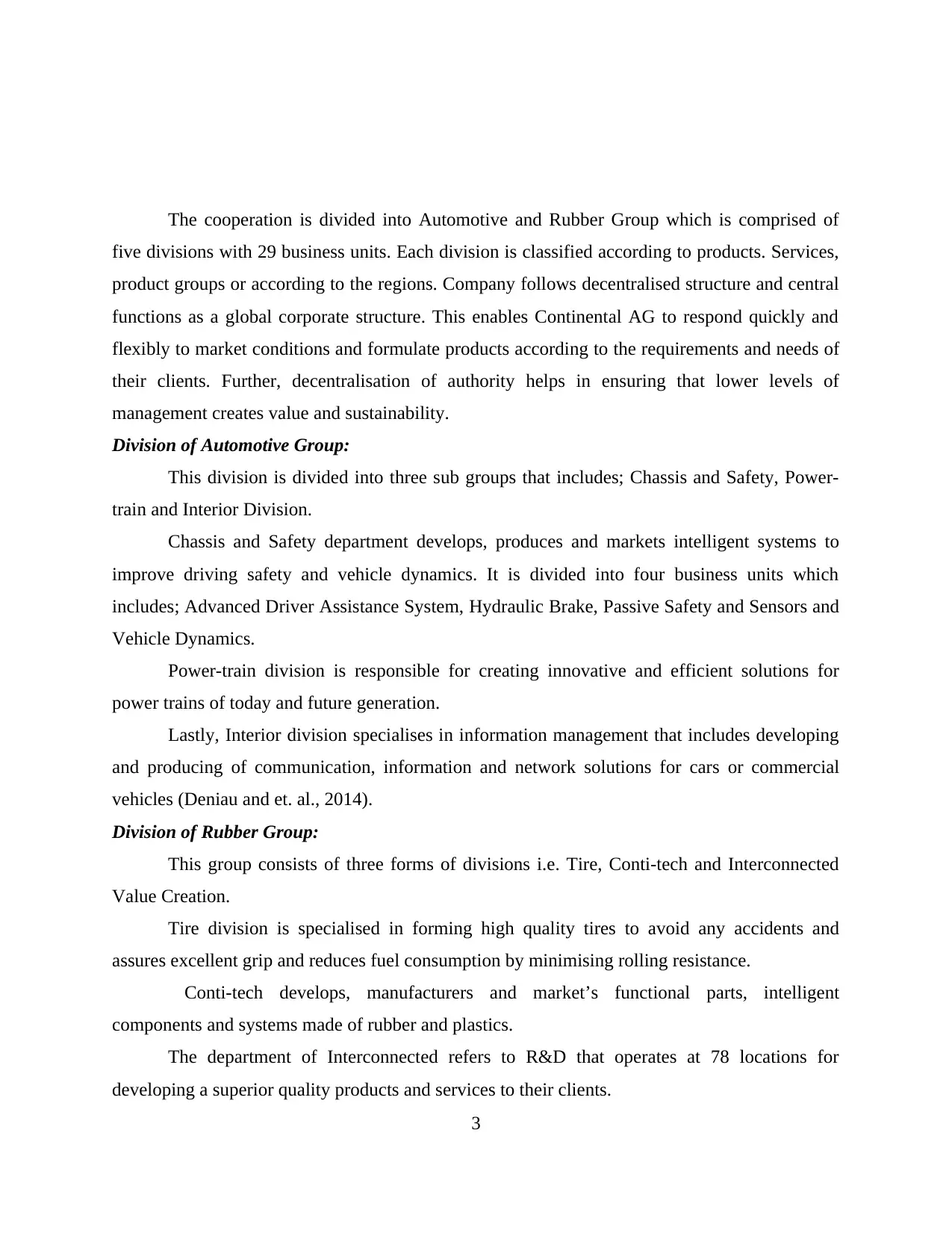
The cooperation is divided into Automotive and Rubber Group which is comprised of
five divisions with 29 business units. Each division is classified according to products. Services,
product groups or according to the regions. Company follows decentralised structure and central
functions as a global corporate structure. This enables Continental AG to respond quickly and
flexibly to market conditions and formulate products according to the requirements and needs of
their clients. Further, decentralisation of authority helps in ensuring that lower levels of
management creates value and sustainability.
Division of Automotive Group:
This division is divided into three sub groups that includes; Chassis and Safety, Power-
train and Interior Division.
Chassis and Safety department develops, produces and markets intelligent systems to
improve driving safety and vehicle dynamics. It is divided into four business units which
includes; Advanced Driver Assistance System, Hydraulic Brake, Passive Safety and Sensors and
Vehicle Dynamics.
Power-train division is responsible for creating innovative and efficient solutions for
power trains of today and future generation.
Lastly, Interior division specialises in information management that includes developing
and producing of communication, information and network solutions for cars or commercial
vehicles (Deniau and et. al., 2014).
Division of Rubber Group:
This group consists of three forms of divisions i.e. Tire, Conti-tech and Interconnected
Value Creation.
Tire division is specialised in forming high quality tires to avoid any accidents and
assures excellent grip and reduces fuel consumption by minimising rolling resistance.
Conti-tech develops, manufacturers and market’s functional parts, intelligent
components and systems made of rubber and plastics.
The department of Interconnected refers to R&D that operates at 78 locations for
developing a superior quality products and services to their clients.
3
five divisions with 29 business units. Each division is classified according to products. Services,
product groups or according to the regions. Company follows decentralised structure and central
functions as a global corporate structure. This enables Continental AG to respond quickly and
flexibly to market conditions and formulate products according to the requirements and needs of
their clients. Further, decentralisation of authority helps in ensuring that lower levels of
management creates value and sustainability.
Division of Automotive Group:
This division is divided into three sub groups that includes; Chassis and Safety, Power-
train and Interior Division.
Chassis and Safety department develops, produces and markets intelligent systems to
improve driving safety and vehicle dynamics. It is divided into four business units which
includes; Advanced Driver Assistance System, Hydraulic Brake, Passive Safety and Sensors and
Vehicle Dynamics.
Power-train division is responsible for creating innovative and efficient solutions for
power trains of today and future generation.
Lastly, Interior division specialises in information management that includes developing
and producing of communication, information and network solutions for cars or commercial
vehicles (Deniau and et. al., 2014).
Division of Rubber Group:
This group consists of three forms of divisions i.e. Tire, Conti-tech and Interconnected
Value Creation.
Tire division is specialised in forming high quality tires to avoid any accidents and
assures excellent grip and reduces fuel consumption by minimising rolling resistance.
Conti-tech develops, manufacturers and market’s functional parts, intelligent
components and systems made of rubber and plastics.
The department of Interconnected refers to R&D that operates at 78 locations for
developing a superior quality products and services to their clients.
3
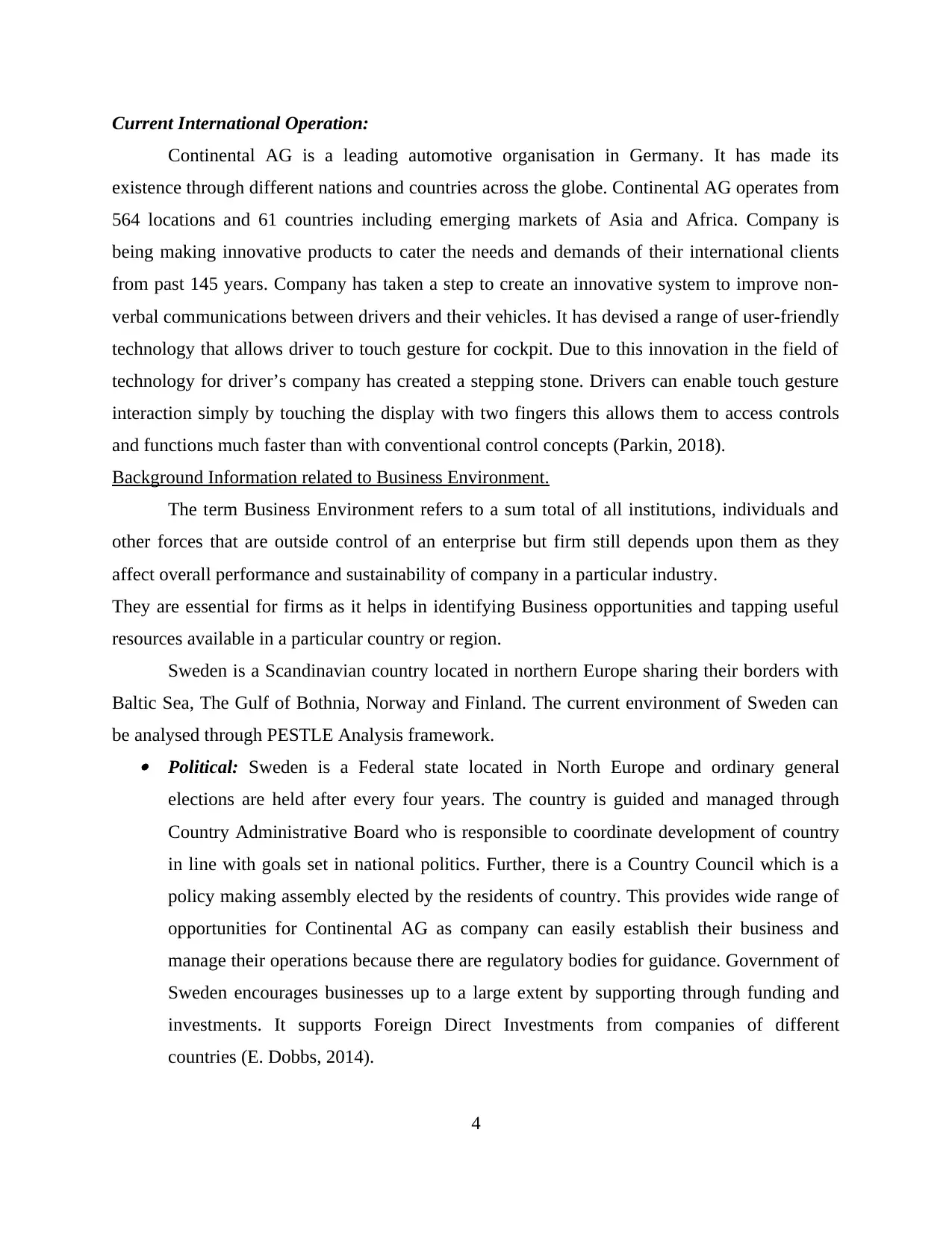
Current International Operation:
Continental AG is a leading automotive organisation in Germany. It has made its
existence through different nations and countries across the globe. Continental AG operates from
564 locations and 61 countries including emerging markets of Asia and Africa. Company is
being making innovative products to cater the needs and demands of their international clients
from past 145 years. Company has taken a step to create an innovative system to improve non-
verbal communications between drivers and their vehicles. It has devised a range of user-friendly
technology that allows driver to touch gesture for cockpit. Due to this innovation in the field of
technology for driver’s company has created a stepping stone. Drivers can enable touch gesture
interaction simply by touching the display with two fingers this allows them to access controls
and functions much faster than with conventional control concepts (Parkin, 2018).
Background Information related to Business Environment.
The term Business Environment refers to a sum total of all institutions, individuals and
other forces that are outside control of an enterprise but firm still depends upon them as they
affect overall performance and sustainability of company in a particular industry.
They are essential for firms as it helps in identifying Business opportunities and tapping useful
resources available in a particular country or region.
Sweden is a Scandinavian country located in northern Europe sharing their borders with
Baltic Sea, The Gulf of Bothnia, Norway and Finland. The current environment of Sweden can
be analysed through PESTLE Analysis framework. Political: Sweden is a Federal state located in North Europe and ordinary general
elections are held after every four years. The country is guided and managed through
Country Administrative Board who is responsible to coordinate development of country
in line with goals set in national politics. Further, there is a Country Council which is a
policy making assembly elected by the residents of country. This provides wide range of
opportunities for Continental AG as company can easily establish their business and
manage their operations because there are regulatory bodies for guidance. Government of
Sweden encourages businesses up to a large extent by supporting through funding and
investments. It supports Foreign Direct Investments from companies of different
countries (E. Dobbs, 2014).
4
Continental AG is a leading automotive organisation in Germany. It has made its
existence through different nations and countries across the globe. Continental AG operates from
564 locations and 61 countries including emerging markets of Asia and Africa. Company is
being making innovative products to cater the needs and demands of their international clients
from past 145 years. Company has taken a step to create an innovative system to improve non-
verbal communications between drivers and their vehicles. It has devised a range of user-friendly
technology that allows driver to touch gesture for cockpit. Due to this innovation in the field of
technology for driver’s company has created a stepping stone. Drivers can enable touch gesture
interaction simply by touching the display with two fingers this allows them to access controls
and functions much faster than with conventional control concepts (Parkin, 2018).
Background Information related to Business Environment.
The term Business Environment refers to a sum total of all institutions, individuals and
other forces that are outside control of an enterprise but firm still depends upon them as they
affect overall performance and sustainability of company in a particular industry.
They are essential for firms as it helps in identifying Business opportunities and tapping useful
resources available in a particular country or region.
Sweden is a Scandinavian country located in northern Europe sharing their borders with
Baltic Sea, The Gulf of Bothnia, Norway and Finland. The current environment of Sweden can
be analysed through PESTLE Analysis framework. Political: Sweden is a Federal state located in North Europe and ordinary general
elections are held after every four years. The country is guided and managed through
Country Administrative Board who is responsible to coordinate development of country
in line with goals set in national politics. Further, there is a Country Council which is a
policy making assembly elected by the residents of country. This provides wide range of
opportunities for Continental AG as company can easily establish their business and
manage their operations because there are regulatory bodies for guidance. Government of
Sweden encourages businesses up to a large extent by supporting through funding and
investments. It supports Foreign Direct Investments from companies of different
countries (E. Dobbs, 2014).
4
⊘ This is a preview!⊘
Do you want full access?
Subscribe today to unlock all pages.

Trusted by 1+ million students worldwide
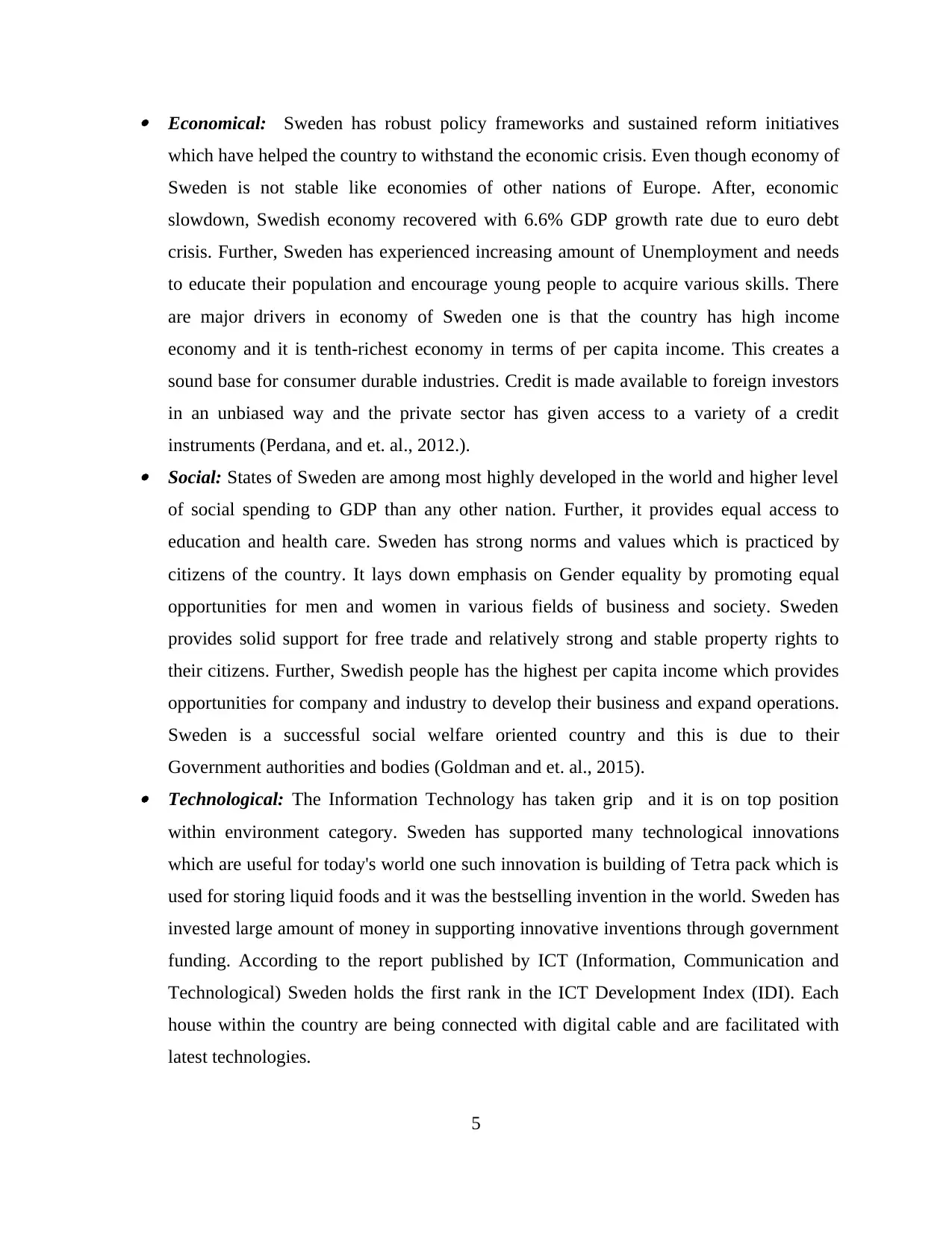
Economical: Sweden has robust policy frameworks and sustained reform initiatives
which have helped the country to withstand the economic crisis. Even though economy of
Sweden is not stable like economies of other nations of Europe. After, economic
slowdown, Swedish economy recovered with 6.6% GDP growth rate due to euro debt
crisis. Further, Sweden has experienced increasing amount of Unemployment and needs
to educate their population and encourage young people to acquire various skills. There
are major drivers in economy of Sweden one is that the country has high income
economy and it is tenth-richest economy in terms of per capita income. This creates a
sound base for consumer durable industries. Credit is made available to foreign investors
in an unbiased way and the private sector has given access to a variety of a credit
instruments (Perdana, and et. al., 2012.). Social: States of Sweden are among most highly developed in the world and higher level
of social spending to GDP than any other nation. Further, it provides equal access to
education and health care. Sweden has strong norms and values which is practiced by
citizens of the country. It lays down emphasis on Gender equality by promoting equal
opportunities for men and women in various fields of business and society. Sweden
provides solid support for free trade and relatively strong and stable property rights to
their citizens. Further, Swedish people has the highest per capita income which provides
opportunities for company and industry to develop their business and expand operations.
Sweden is a successful social welfare oriented country and this is due to their
Government authorities and bodies (Goldman and et. al., 2015). Technological: The Information Technology has taken grip and it is on top position
within environment category. Sweden has supported many technological innovations
which are useful for today's world one such innovation is building of Tetra pack which is
used for storing liquid foods and it was the bestselling invention in the world. Sweden has
invested large amount of money in supporting innovative inventions through government
funding. According to the report published by ICT (Information, Communication and
Technological) Sweden holds the first rank in the ICT Development Index (IDI). Each
house within the country are being connected with digital cable and are facilitated with
latest technologies.
5
which have helped the country to withstand the economic crisis. Even though economy of
Sweden is not stable like economies of other nations of Europe. After, economic
slowdown, Swedish economy recovered with 6.6% GDP growth rate due to euro debt
crisis. Further, Sweden has experienced increasing amount of Unemployment and needs
to educate their population and encourage young people to acquire various skills. There
are major drivers in economy of Sweden one is that the country has high income
economy and it is tenth-richest economy in terms of per capita income. This creates a
sound base for consumer durable industries. Credit is made available to foreign investors
in an unbiased way and the private sector has given access to a variety of a credit
instruments (Perdana, and et. al., 2012.). Social: States of Sweden are among most highly developed in the world and higher level
of social spending to GDP than any other nation. Further, it provides equal access to
education and health care. Sweden has strong norms and values which is practiced by
citizens of the country. It lays down emphasis on Gender equality by promoting equal
opportunities for men and women in various fields of business and society. Sweden
provides solid support for free trade and relatively strong and stable property rights to
their citizens. Further, Swedish people has the highest per capita income which provides
opportunities for company and industry to develop their business and expand operations.
Sweden is a successful social welfare oriented country and this is due to their
Government authorities and bodies (Goldman and et. al., 2015). Technological: The Information Technology has taken grip and it is on top position
within environment category. Sweden has supported many technological innovations
which are useful for today's world one such innovation is building of Tetra pack which is
used for storing liquid foods and it was the bestselling invention in the world. Sweden has
invested large amount of money in supporting innovative inventions through government
funding. According to the report published by ICT (Information, Communication and
Technological) Sweden holds the first rank in the ICT Development Index (IDI). Each
house within the country are being connected with digital cable and are facilitated with
latest technologies.
5
Paraphrase This Document
Need a fresh take? Get an instant paraphrase of this document with our AI Paraphraser
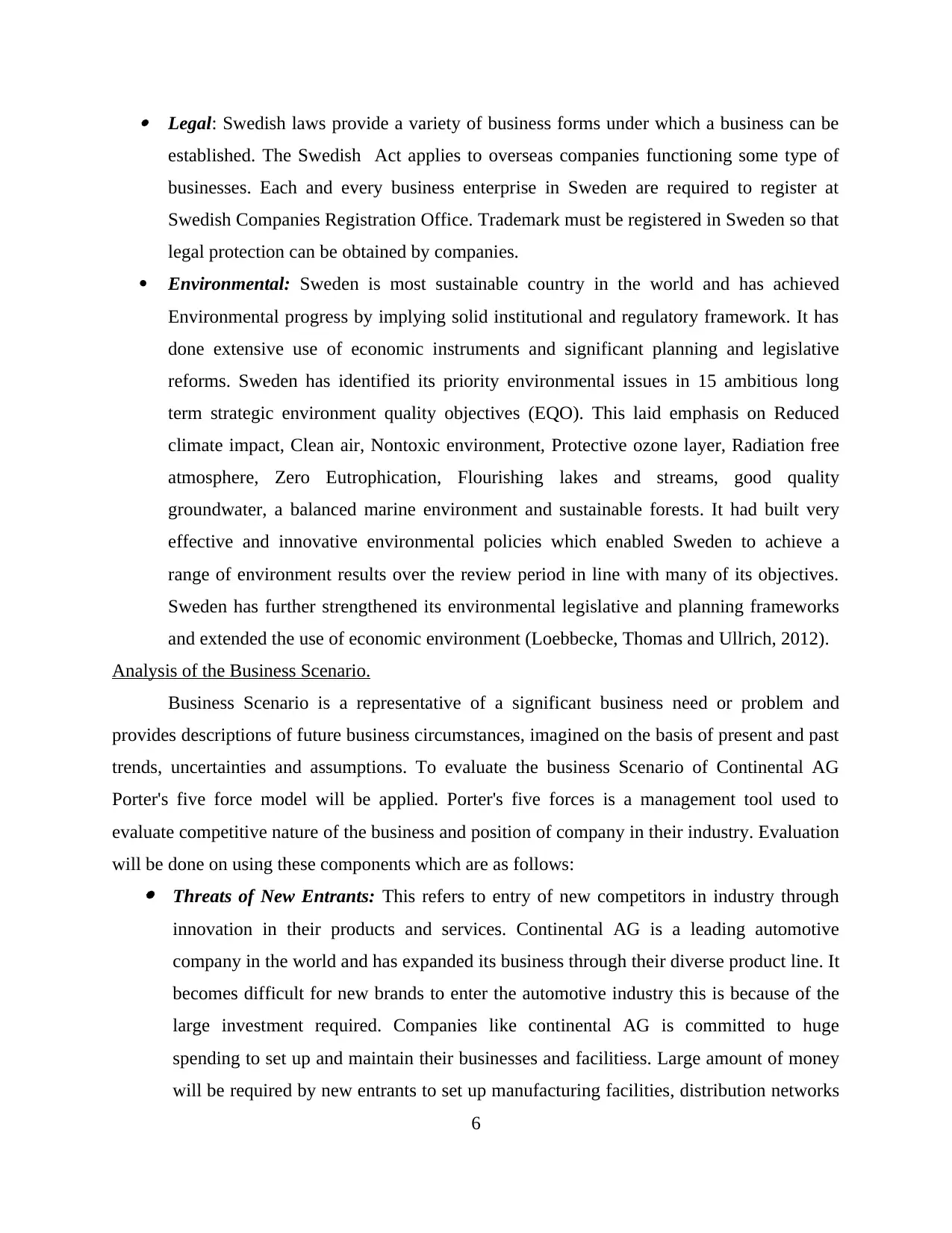
Legal: Swedish laws provide a variety of business forms under which a business can be
established. The Swedish Act applies to overseas companies functioning some type of
businesses. Each and every business enterprise in Sweden are required to register at
Swedish Companies Registration Office. Trademark must be registered in Sweden so that
legal protection can be obtained by companies.
Environmental: Sweden is most sustainable country in the world and has achieved
Environmental progress by implying solid institutional and regulatory framework. It has
done extensive use of economic instruments and significant planning and legislative
reforms. Sweden has identified its priority environmental issues in 15 ambitious long
term strategic environment quality objectives (EQO). This laid emphasis on Reduced
climate impact, Clean air, Nontoxic environment, Protective ozone layer, Radiation free
atmosphere, Zero Eutrophication, Flourishing lakes and streams, good quality
groundwater, a balanced marine environment and sustainable forests. It had built very
effective and innovative environmental policies which enabled Sweden to achieve a
range of environment results over the review period in line with many of its objectives.
Sweden has further strengthened its environmental legislative and planning frameworks
and extended the use of economic environment (Loebbecke, Thomas and Ullrich, 2012).
Analysis of the Business Scenario.
Business Scenario is a representative of a significant business need or problem and
provides descriptions of future business circumstances, imagined on the basis of present and past
trends, uncertainties and assumptions. To evaluate the business Scenario of Continental AG
Porter's five force model will be applied. Porter's five forces is a management tool used to
evaluate competitive nature of the business and position of company in their industry. Evaluation
will be done on using these components which are as follows: Threats of New Entrants: This refers to entry of new competitors in industry through
innovation in their products and services. Continental AG is a leading automotive
company in the world and has expanded its business through their diverse product line. It
becomes difficult for new brands to enter the automotive industry this is because of the
large investment required. Companies like continental AG is committed to huge
spending to set up and maintain their businesses and facilitiess. Large amount of money
will be required by new entrants to set up manufacturing facilities, distribution networks
6
established. The Swedish Act applies to overseas companies functioning some type of
businesses. Each and every business enterprise in Sweden are required to register at
Swedish Companies Registration Office. Trademark must be registered in Sweden so that
legal protection can be obtained by companies.
Environmental: Sweden is most sustainable country in the world and has achieved
Environmental progress by implying solid institutional and regulatory framework. It has
done extensive use of economic instruments and significant planning and legislative
reforms. Sweden has identified its priority environmental issues in 15 ambitious long
term strategic environment quality objectives (EQO). This laid emphasis on Reduced
climate impact, Clean air, Nontoxic environment, Protective ozone layer, Radiation free
atmosphere, Zero Eutrophication, Flourishing lakes and streams, good quality
groundwater, a balanced marine environment and sustainable forests. It had built very
effective and innovative environmental policies which enabled Sweden to achieve a
range of environment results over the review period in line with many of its objectives.
Sweden has further strengthened its environmental legislative and planning frameworks
and extended the use of economic environment (Loebbecke, Thomas and Ullrich, 2012).
Analysis of the Business Scenario.
Business Scenario is a representative of a significant business need or problem and
provides descriptions of future business circumstances, imagined on the basis of present and past
trends, uncertainties and assumptions. To evaluate the business Scenario of Continental AG
Porter's five force model will be applied. Porter's five forces is a management tool used to
evaluate competitive nature of the business and position of company in their industry. Evaluation
will be done on using these components which are as follows: Threats of New Entrants: This refers to entry of new competitors in industry through
innovation in their products and services. Continental AG is a leading automotive
company in the world and has expanded its business through their diverse product line. It
becomes difficult for new brands to enter the automotive industry this is because of the
large investment required. Companies like continental AG is committed to huge
spending to set up and maintain their businesses and facilitiess. Large amount of money
will be required by new entrants to set up manufacturing facilities, distribution networks
6
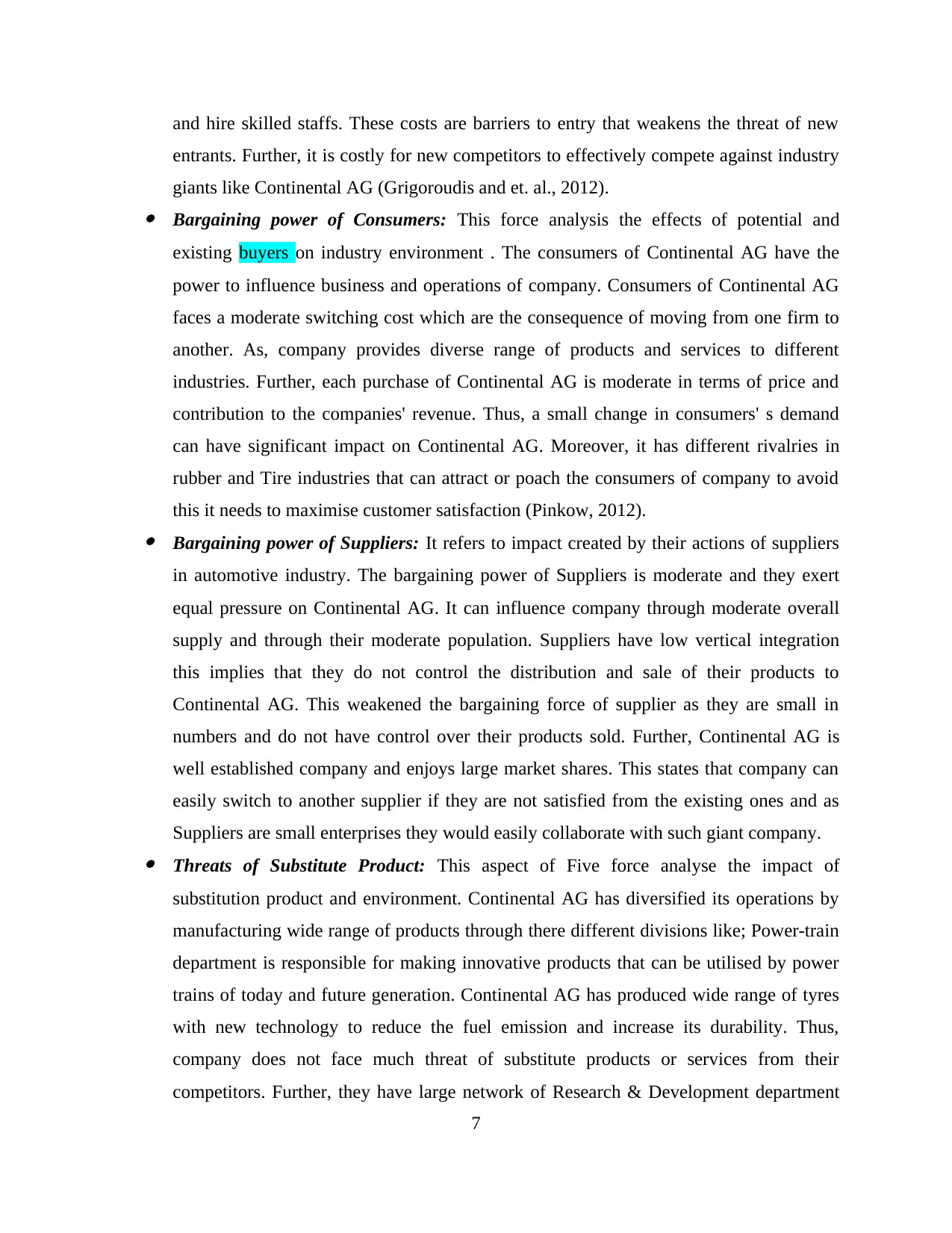
and hire skilled staffs. These costs are barriers to entry that weakens the threat of new
entrants. Further, it is costly for new competitors to effectively compete against industry
giants like Continental AG (Grigoroudis and et. al., 2012). Bargaining power of Consumers: This force analysis the effects of potential and
existing buyers on industry environment . The consumers of Continental AG have the
power to influence business and operations of company. Consumers of Continental AG
faces a moderate switching cost which are the consequence of moving from one firm to
another. As, company provides diverse range of products and services to different
industries. Further, each purchase of Continental AG is moderate in terms of price and
contribution to the companies' revenue. Thus, a small change in consumers' s demand
can have significant impact on Continental AG. Moreover, it has different rivalries in
rubber and Tire industries that can attract or poach the consumers of company to avoid
this it needs to maximise customer satisfaction (Pinkow, 2012). Bargaining power of Suppliers: It refers to impact created by their actions of suppliers
in automotive industry. The bargaining power of Suppliers is moderate and they exert
equal pressure on Continental AG. It can influence company through moderate overall
supply and through their moderate population. Suppliers have low vertical integration
this implies that they do not control the distribution and sale of their products to
Continental AG. This weakened the bargaining force of supplier as they are small in
numbers and do not have control over their products sold. Further, Continental AG is
well established company and enjoys large market shares. This states that company can
easily switch to another supplier if they are not satisfied from the existing ones and as
Suppliers are small enterprises they would easily collaborate with such giant company. Threats of Substitute Product: This aspect of Five force analyse the impact of
substitution product and environment. Continental AG has diversified its operations by
manufacturing wide range of products through there different divisions like; Power-train
department is responsible for making innovative products that can be utilised by power
trains of today and future generation. Continental AG has produced wide range of tyres
with new technology to reduce the fuel emission and increase its durability. Thus,
company does not face much threat of substitute products or services from their
competitors. Further, they have large network of Research & Development department
7
entrants. Further, it is costly for new competitors to effectively compete against industry
giants like Continental AG (Grigoroudis and et. al., 2012). Bargaining power of Consumers: This force analysis the effects of potential and
existing buyers on industry environment . The consumers of Continental AG have the
power to influence business and operations of company. Consumers of Continental AG
faces a moderate switching cost which are the consequence of moving from one firm to
another. As, company provides diverse range of products and services to different
industries. Further, each purchase of Continental AG is moderate in terms of price and
contribution to the companies' revenue. Thus, a small change in consumers' s demand
can have significant impact on Continental AG. Moreover, it has different rivalries in
rubber and Tire industries that can attract or poach the consumers of company to avoid
this it needs to maximise customer satisfaction (Pinkow, 2012). Bargaining power of Suppliers: It refers to impact created by their actions of suppliers
in automotive industry. The bargaining power of Suppliers is moderate and they exert
equal pressure on Continental AG. It can influence company through moderate overall
supply and through their moderate population. Suppliers have low vertical integration
this implies that they do not control the distribution and sale of their products to
Continental AG. This weakened the bargaining force of supplier as they are small in
numbers and do not have control over their products sold. Further, Continental AG is
well established company and enjoys large market shares. This states that company can
easily switch to another supplier if they are not satisfied from the existing ones and as
Suppliers are small enterprises they would easily collaborate with such giant company. Threats of Substitute Product: This aspect of Five force analyse the impact of
substitution product and environment. Continental AG has diversified its operations by
manufacturing wide range of products through there different divisions like; Power-train
department is responsible for making innovative products that can be utilised by power
trains of today and future generation. Continental AG has produced wide range of tyres
with new technology to reduce the fuel emission and increase its durability. Thus,
company does not face much threat of substitute products or services from their
competitors. Further, they have large network of Research & Development department
7
⊘ This is a preview!⊘
Do you want full access?
Subscribe today to unlock all pages.

Trusted by 1+ million students worldwide
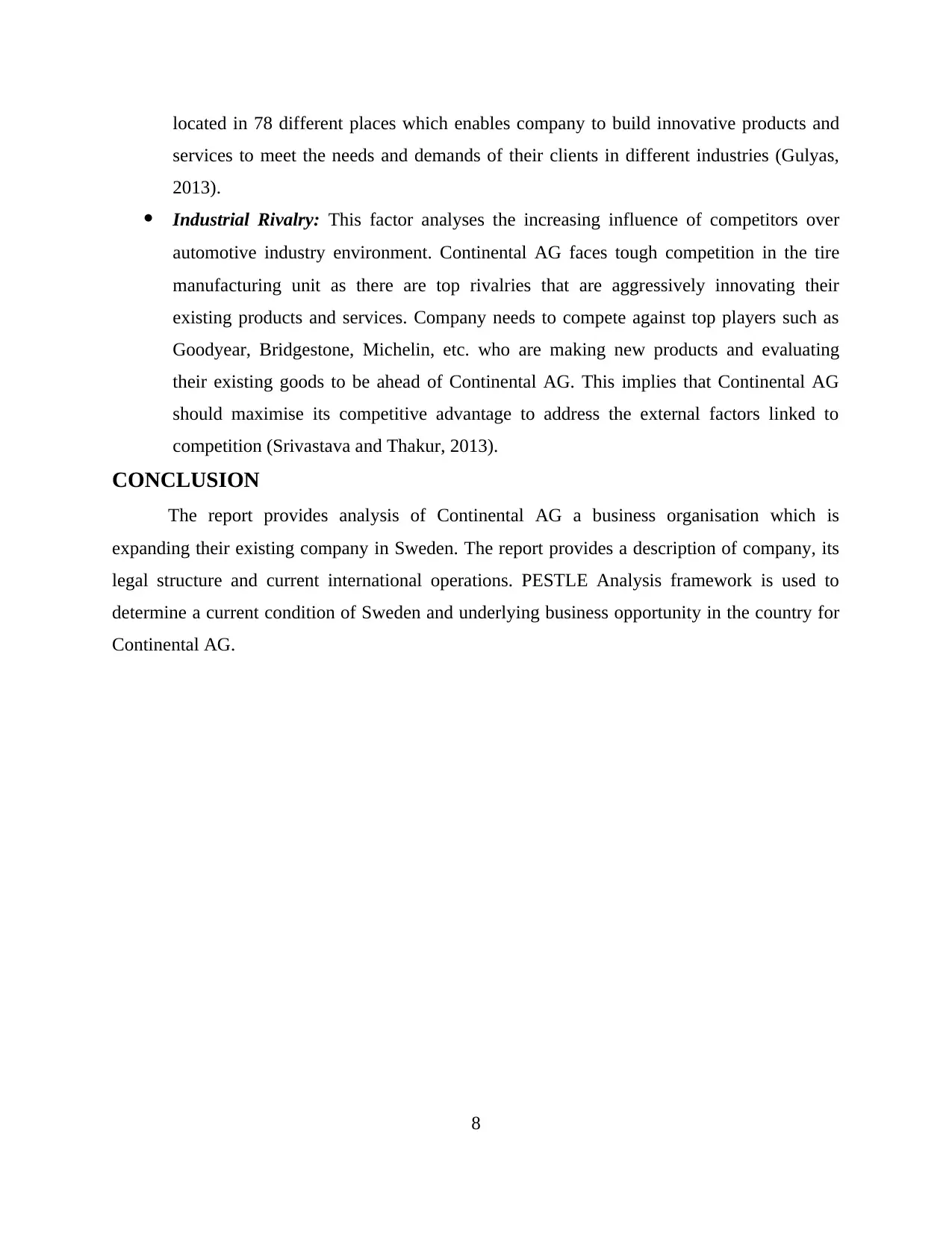
located in 78 different places which enables company to build innovative products and
services to meet the needs and demands of their clients in different industries (Gulyas,
2013).
Industrial Rivalry: This factor analyses the increasing influence of competitors over
automotive industry environment. Continental AG faces tough competition in the tire
manufacturing unit as there are top rivalries that are aggressively innovating their
existing products and services. Company needs to compete against top players such as
Goodyear, Bridgestone, Michelin, etc. who are making new products and evaluating
their existing goods to be ahead of Continental AG. This implies that Continental AG
should maximise its competitive advantage to address the external factors linked to
competition (Srivastava and Thakur, 2013).
CONCLUSION
The report provides analysis of Continental AG a business organisation which is
expanding their existing company in Sweden. The report provides a description of company, its
legal structure and current international operations. PESTLE Analysis framework is used to
determine a current condition of Sweden and underlying business opportunity in the country for
Continental AG.
8
services to meet the needs and demands of their clients in different industries (Gulyas,
2013).
Industrial Rivalry: This factor analyses the increasing influence of competitors over
automotive industry environment. Continental AG faces tough competition in the tire
manufacturing unit as there are top rivalries that are aggressively innovating their
existing products and services. Company needs to compete against top players such as
Goodyear, Bridgestone, Michelin, etc. who are making new products and evaluating
their existing goods to be ahead of Continental AG. This implies that Continental AG
should maximise its competitive advantage to address the external factors linked to
competition (Srivastava and Thakur, 2013).
CONCLUSION
The report provides analysis of Continental AG a business organisation which is
expanding their existing company in Sweden. The report provides a description of company, its
legal structure and current international operations. PESTLE Analysis framework is used to
determine a current condition of Sweden and underlying business opportunity in the country for
Continental AG.
8
Paraphrase This Document
Need a fresh take? Get an instant paraphrase of this document with our AI Paraphraser
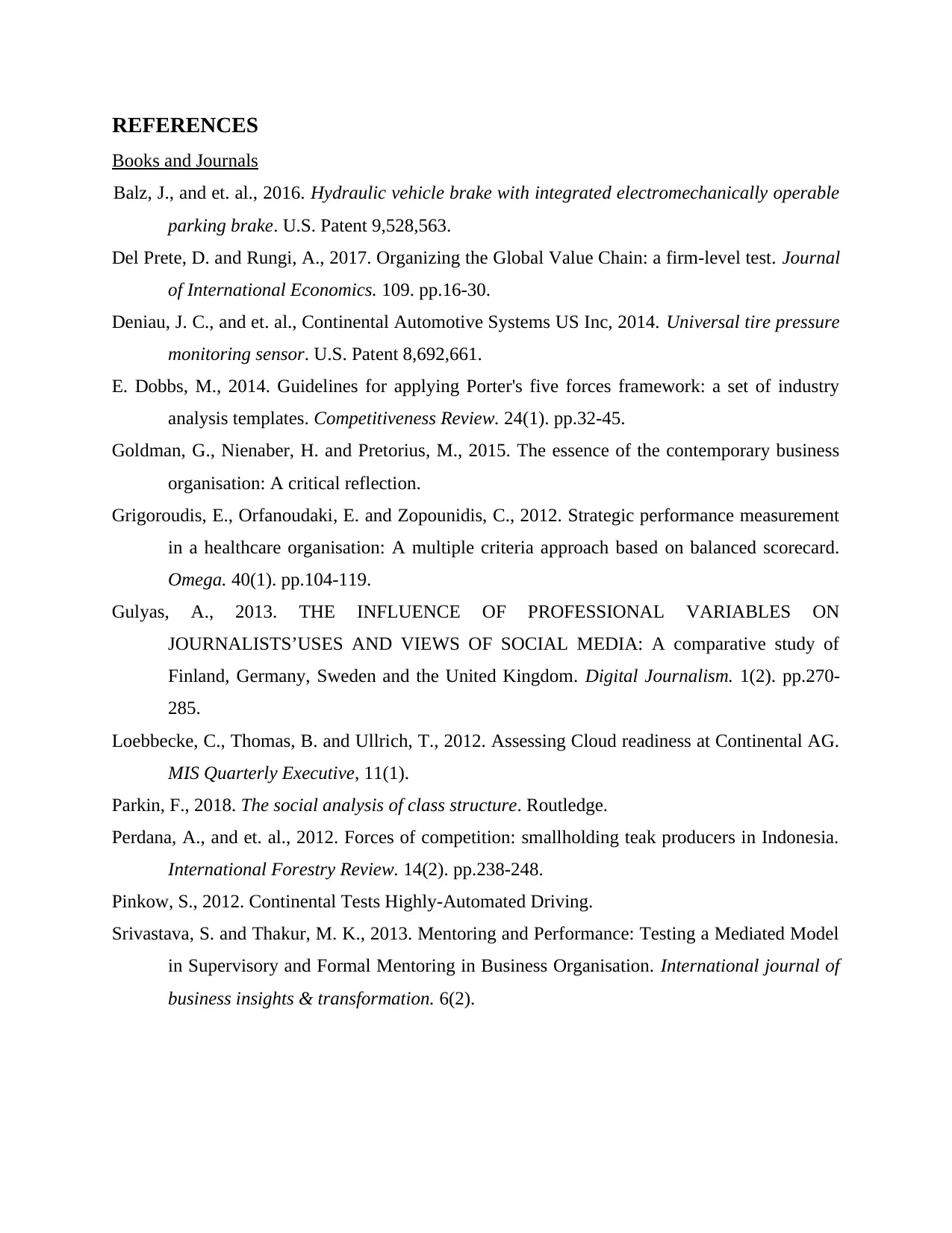
REFERENCES
Books and Journals
Balz, J., and et. al., 2016. Hydraulic vehicle brake with integrated electromechanically operable
parking brake. U.S. Patent 9,528,563.
Del Prete, D. and Rungi, A., 2017. Organizing the Global Value Chain: a firm-level test. Journal
of International Economics. 109. pp.16-30.
Deniau, J. C., and et. al., Continental Automotive Systems US Inc, 2014. Universal tire pressure
monitoring sensor. U.S. Patent 8,692,661.
E. Dobbs, M., 2014. Guidelines for applying Porter's five forces framework: a set of industry
analysis templates. Competitiveness Review. 24(1). pp.32-45.
Goldman, G., Nienaber, H. and Pretorius, M., 2015. The essence of the contemporary business
organisation: A critical reflection.
Grigoroudis, E., Orfanoudaki, E. and Zopounidis, C., 2012. Strategic performance measurement
in a healthcare organisation: A multiple criteria approach based on balanced scorecard.
Omega. 40(1). pp.104-119.
Gulyas, A., 2013. THE INFLUENCE OF PROFESSIONAL VARIABLES ON
JOURNALISTS’USES AND VIEWS OF SOCIAL MEDIA: A comparative study of
Finland, Germany, Sweden and the United Kingdom. Digital Journalism. 1(2). pp.270-
285.
Loebbecke, C., Thomas, B. and Ullrich, T., 2012. Assessing Cloud readiness at Continental AG.
MIS Quarterly Executive, 11(1).
Parkin, F., 2018. The social analysis of class structure. Routledge.
Perdana, A., and et. al., 2012. Forces of competition: smallholding teak producers in Indonesia.
International Forestry Review. 14(2). pp.238-248.
Pinkow, S., 2012. Continental Tests Highly-Automated Driving.
Srivastava, S. and Thakur, M. K., 2013. Mentoring and Performance: Testing a Mediated Model
in Supervisory and Formal Mentoring in Business Organisation. International journal of
business insights & transformation. 6(2).
Books and Journals
Balz, J., and et. al., 2016. Hydraulic vehicle brake with integrated electromechanically operable
parking brake. U.S. Patent 9,528,563.
Del Prete, D. and Rungi, A., 2017. Organizing the Global Value Chain: a firm-level test. Journal
of International Economics. 109. pp.16-30.
Deniau, J. C., and et. al., Continental Automotive Systems US Inc, 2014. Universal tire pressure
monitoring sensor. U.S. Patent 8,692,661.
E. Dobbs, M., 2014. Guidelines for applying Porter's five forces framework: a set of industry
analysis templates. Competitiveness Review. 24(1). pp.32-45.
Goldman, G., Nienaber, H. and Pretorius, M., 2015. The essence of the contemporary business
organisation: A critical reflection.
Grigoroudis, E., Orfanoudaki, E. and Zopounidis, C., 2012. Strategic performance measurement
in a healthcare organisation: A multiple criteria approach based on balanced scorecard.
Omega. 40(1). pp.104-119.
Gulyas, A., 2013. THE INFLUENCE OF PROFESSIONAL VARIABLES ON
JOURNALISTS’USES AND VIEWS OF SOCIAL MEDIA: A comparative study of
Finland, Germany, Sweden and the United Kingdom. Digital Journalism. 1(2). pp.270-
285.
Loebbecke, C., Thomas, B. and Ullrich, T., 2012. Assessing Cloud readiness at Continental AG.
MIS Quarterly Executive, 11(1).
Parkin, F., 2018. The social analysis of class structure. Routledge.
Perdana, A., and et. al., 2012. Forces of competition: smallholding teak producers in Indonesia.
International Forestry Review. 14(2). pp.238-248.
Pinkow, S., 2012. Continental Tests Highly-Automated Driving.
Srivastava, S. and Thakur, M. K., 2013. Mentoring and Performance: Testing a Mediated Model
in Supervisory and Formal Mentoring in Business Organisation. International journal of
business insights & transformation. 6(2).

⊘ This is a preview!⊘
Do you want full access?
Subscribe today to unlock all pages.

Trusted by 1+ million students worldwide
1 out of 12
Related Documents
Your All-in-One AI-Powered Toolkit for Academic Success.
+13062052269
info@desklib.com
Available 24*7 on WhatsApp / Email
![[object Object]](/_next/static/media/star-bottom.7253800d.svg)
Unlock your academic potential
© 2024 | Zucol Services PVT LTD | All rights reserved.




